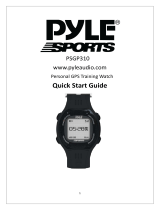
Table of Contents
Introduction.....................................................................1
Keys............................................................................................ 1
Locking the Keys....................................................................1
Charging the Device................................................................... 1
Pairing Your Smartphone with Your Device............................... 1
Support and Updates.................................................................. 1
Setting Up Garmin Express................................................... 1
Heart Rate Features....................................................... 1
Wrist-based Heart Rate.............................................................. 2
Wearing the Device and Heart Rate...................................... 2
Tips for Erratic Heart Rate Data.............................................2
Viewing the Heart Rate Widget.............................................. 2
Broadcasting Heart Rate Data to Garmin Devices................ 2
Turning Off the Wrist Heart Rate Monitor.............................. 2
Putting On the Heart Rate Monitor............................................. 2
Tips for Erratic Heart Rate Data.............................................2
Running Dynamics......................................................................3
Training with Running Dynamics........................................... 3
Color Gauges and Running Dynamics Data.......................... 3
Ground Contact Time Balance Data................................. 3
Tips for Missing Running Dynamics Data.............................. 4
Physiological Measurements...................................................... 4
About VO2 Max. Estimates.................................................... 4
Getting Your VO2 Max. Estimate for Running.................. 4
Getting Your VO2 Max. Estimate for Cycling.................... 4
Viewing Your Predicted Race Times..................................... 4
Recovery Advisor................................................................... 5
Turning On the Recovery Advisor..................................... 5
Recovery Heart Rate............................................................. 5
Lactate Threshold.................................................................. 5
Performing a Guided Test to Determine Your Lactate
Threshold.......................................................................... 5
Performance Condition.......................................................... 5
Viewing Your Performance Condition............................... 5
Stress Score.......................................................................... 5
Viewing Your Stress Score............................................... 5
Activities......................................................................... 5
Starting an Activity...................................................................... 5
Stopping an Activity.................................................................... 6
Skiing.......................................................................................... 6
Going Cross-Country Skiing.................................................. 6
Going Downhill Skiing or Snowboarding................................ 6
Viewing Your Ski Runs......................................................6
Hiking.......................................................................................... 6
Going for a Hike..................................................................... 6
Running...................................................................................... 6
Going for a Run......................................................................6
Using the Metronome.............................................................6
Biking.......................................................................................... 7
Going for a Ride..................................................................... 7
Swimming................................................................................... 7
Going for a Pool Swim........................................................... 7
Swim Terminology.............................................................7
Stroke Types..................................................................... 7
Resting During Pool Swimming.........................................7
Training with the Drill Log..................................................7
Going for an Open Water Swim............................................. 7
Water Sports............................................................................... 8
Starting a Stand Up Paddle Boarding Activity....................... 8
Starting a Rowing Activity...................................................... 8
Indoor Activities.......................................................................... 8
Multisport.................................................................................... 8
Starting a Triathlon or Multisport Activity............................... 8
Creating a Custom Activity.....................................................8
Golfing........................................................................................ 8
Playing Golf............................................................................8
Hole Information.....................................................................8
Viewing Layup and Dogleg Distances................................... 9
Using the Golf Odometer....................................................... 9
Keeping Score....................................................................... 9
Reviewing Scores.................................................................. 9
Measuring a Shot................................................................... 9
Training........................................................................... 9
Setting Up Your User Profile.......................................................9
Fitness Goals......................................................................... 9
About Heart Rate Zones........................................................ 9
Setting Your Heart Rate Zones......................................... 9
Letting the Device Set Your Heart Rate Zones............... 10
Heart Rate Zone Calculations......................................... 10
About Lifetime Athletes........................................................ 10
Setting Your Power Zones................................................... 10
Activity Tracking........................................................................10
Turning On Activity Tracking................................................ 10
Using the Move Alert............................................................10
Auto Goal............................................................................. 10
Sleep Tracking..................................................................... 10
Using Automated Sleep Tracking....................................10
Using Do Not Disturb Mode............................................ 10
Intensity Minutes.................................................................. 11
Workouts...................................................................................11
Following a Workout From the Web.....................................11
Starting a Workout............................................................... 11
About the Training Calendar................................................ 11
Using Garmin Connect Training Plans............................ 11
Interval Workouts...................................................................... 11
Creating an Interval Workout............................................... 11
Starting an Interval Workout................................................ 11
Stopping an Interval Workout...............................................11
Using Virtual Partner®.............................................................. 11
Setting a Training Target.......................................................... 12
Cancelling a Training Target................................................ 12
Racing a Previous Activity........................................................ 12
Personal Records..................................................................... 12
Viewing Your Personal Records.......................................... 12
Restoring a Personal Record............................................... 12
Clearing a Personal Record................................................. 12
Clearing All Personal Records............................................. 12
About Training Effect................................................................ 12
Clock.............................................................................. 12
Setting an Alarm....................................................................... 12
Starting the Countdown Timer.................................................. 13
Using the Stopwatch................................................................. 13
Setting Sunrise and Sunset Alerts............................................ 13
Navigation..................................................................... 13
Projecting a Waypoint............................................................... 13
Saving Your Location............................................................... 13
Editing Your Saved Locations.............................................. 13
Editing Your Saved Locations.................................................. 13
Deleting All Saved Locations.................................................... 13
Navigating to a Destination....................................................... 13
Navigating with Sight 'N Go...................................................... 13
Compass...................................................................................13
Map........................................................................................... 13
Panning and Zooming the Map............................................ 13
Navigating To Your Starting Point............................................ 14
Altimeter and Barometer........................................................... 14
History........................................................................... 14
Using History............................................................................ 14
Table of Contents i




















